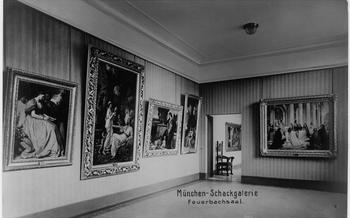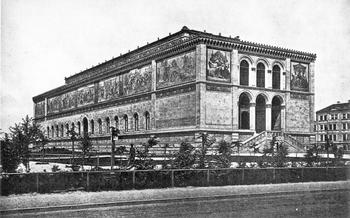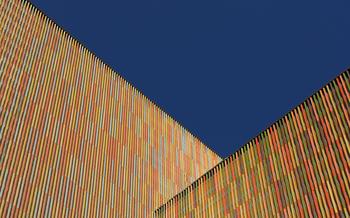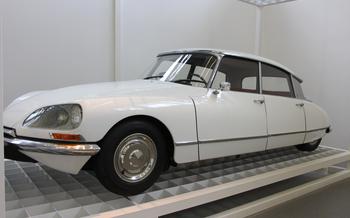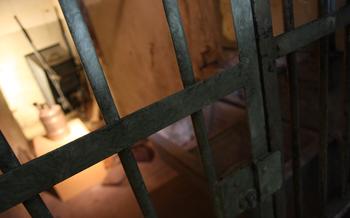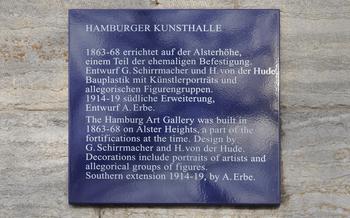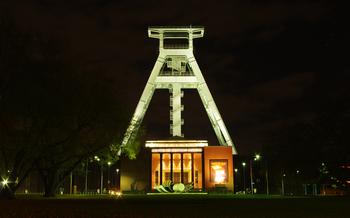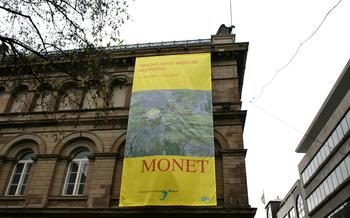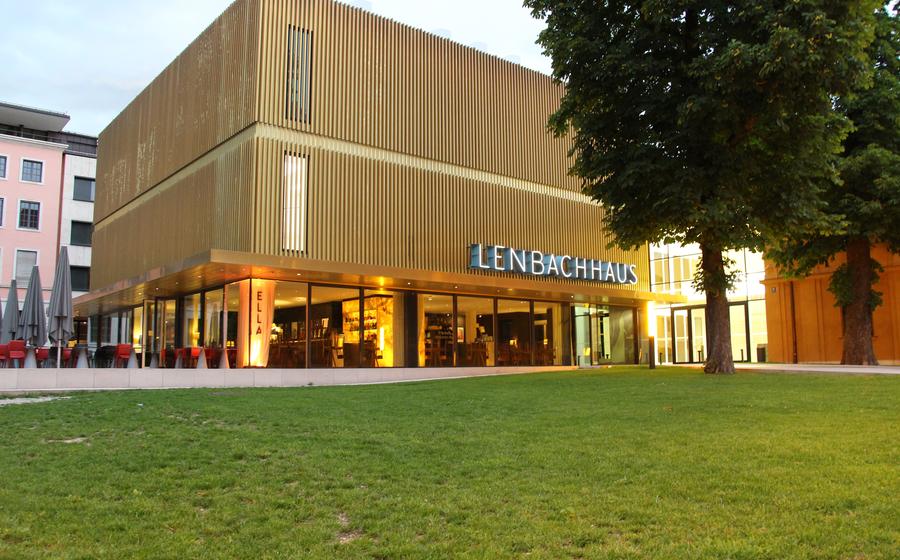
Lenbachhaus
- Lenbachhaus: A Journey Through Art History
- The Blue Rider Movement: A Revolution in Art
- Masterpieces of the Lenbachhaus Collection
- Exploring the Lenbachhaus Galleries
- Special Exhibitions and Events
- Location and Accessibility
- Planning Your Visit
- Audio Guide and Guided Tours
- Museum Shop and Café
- Educational Programs and Workshops
- Combining Art and History
- Lenbachhaus for Children and Families
- Photography and Social Media
- Sustainable Practices: A Commitment to the Environment
- Insider Tip: Hidden Gem
Lenbachhaus: A Journey Through Art History
The Lenbachhaus, nestled in the heart of Munich's Kunstareal, is a treasure trove of art and history, inviting visitors on a captivating journey through German art from the 19th and 20th centuries. Housed in a magnificent Neo-Renaissance building, the museum showcases a remarkable collection that spans various artistic movements, with a particular focus on the groundbreaking Blue Rider group.
The Lenbachhaus stands as a testament to the vibrant art scene that flourished in Munich during the late 19th and early 20th centuries. Founded in 1929, the museum initially focused on the work of Franz von Lenbach, a renowned portraitist and contemporary of the Blue Rider artists. However, over the years, the collection has expanded to encompass a diverse range of artworks, including paintings, sculptures, and drawings by some of the most influential figures in German art history.
The architectural style of the Lenbachhaus itself is a work of art, mirroring the transition between historicism and modernism. Designed by Gabriel von Seidl, the building features a striking combination of Neo-Renaissance elements, such as the grand entrance with its elaborate ornamentation, and Art Nouveau influences, evident in the flowing lines and organic motifs.
The museum's collection boasts iconic masterpieces by Blue Rider artists, such as Wassily Kandinsky's groundbreaking "Composition VII" and Franz Marc's vibrant "Blue Horse." These works, characterized by their bold colors, abstract forms, and emotional intensity, offer a glimpse into the revolutionary spirit of the early 20th century. Beyond the Blue Rider movement, the Lenbachhaus also houses notable works by other renowned German artists, including Caspar David Friedrich, Lovis Corinth, and Max Beckmann, providing a comprehensive overview of the diverse artistic currents that shaped German art during this transformative period.
The Blue Rider Movement: A Revolution in Art
At the turn of the 20th century, Munich became a hotbed of artistic experimentation and innovation, giving birth to the groundbreaking Blue Rider movement. This group of avant-garde artists, led by Wassily Kandinsky and Franz Marc, sought to challenge traditional notions of representation and explore the expressive potential of color and form.
The Blue Rider artists were united by their belief in the spiritual and emotional power of art. They rejected the prevailing naturalism and realism of the time, instead embracing abstraction and symbolism to convey their inner worlds and evoke a sense of transcendence. Their works were characterized by vibrant colors, bold lines, and dynamic compositions, often featuring mystical motifs and dreamlike imagery.
Kandinsky, a Russian painter and theorist, is considered one of the pioneers of abstract art. His groundbreaking work, "Composition VII," created in 1913, is a masterpiece of the Blue Rider movement. The painting features a symphony of geometric shapes and vibrant colors, arranged in a harmonious yet chaotic composition that evokes a sense of movement and energy.
Franz Marc, a German painter, was another key figure in the Blue Rider movement. His works often depicted animals, rendered in simplified forms and imbued with symbolic meanings. His iconic painting, "Blue Horse," created in 1911, exemplifies the movement's emphasis on color and emotion. The vibrant blue hue of the horse conveys a sense of spirituality and transcendence, while the simplified form suggests a connection to the animal's inner essence.
The Blue Rider movement had a profound impact on the development of modern and contemporary art. Its radical approach to representation and its emphasis on emotional expression paved the way for new artistic movements and styles, such as Expressionism and Abstractionism. The works of Kandinsky, Marc, and other Blue Rider artists continue to inspire and challenge viewers to this day.
Masterpieces of the Lenbachhaus Collection
The Lenbachhaus boasts a remarkable collection of artworks from the 19th and 20th centuries, with a particular focus on the Blue Rider movement. Among the highlights of the permanent collection are iconic works by Wassily Kandinsky and Franz Marc, two of the group's most prominent members.
Kandinsky's "Composition VII," created in 1913, is a masterpiece of abstract art. The painting is a symphony of colors and shapes, evoking a sense of movement and energy. Marc's "Blue Horse," painted in 1911, is another iconic work from the Blue Rider period. The painting depicts a solitary horse, rendered in vibrant shades of blue, symbolizing the spiritual connection between humans and nature.
In addition to these masterpieces, the Lenbachhaus collection features notable works by other Blue Rider artists, such as Gabriele Münter, Alexej von Jawlensky, and Marianne von Werefkin. The museum also houses an impressive collection of paintings, sculptures, and drawings from the Romantic, Realist, and Impressionist periods, including works by Caspar David Friedrich, Wilhelm Leibl, and Max Liebermann.
Curatorial insights and stories behind the artworks provide visitors with a deeper understanding of the collection. Through audio guides, guided tours, and interactive displays, visitors can learn about the artistic techniques, influences, and historical context of the artworks. The Lenbachhaus also organizes special exhibitions and events that explore the lives and works of specific artists or delve into particular themes related to German art.
Exploring the Lenbachhaus Galleries
The Lenbachhaus is a labyrinth of galleries, each one a treasure trove of art from different periods and movements. The museum's layout is designed to take visitors on a chronological journey through the history of German art, beginning with the 19th-century Realists and Impressionists and culminating in the groundbreaking works of the Blue Rider movement.
Thematic galleries focus on specific artists or groups, such as the Blue Rider room, which houses masterpieces by Wassily Kandinsky, Franz Marc, and other members of the group. The museum also features a dedicated gallery for the works of Franz von Lenbach, the artist who originally resided in the villa and whose collection formed the foundation of the museum.
Interactive displays and multimedia presentations enhance the visitor experience, providing deeper insights into the artworks and the artists who created them. Guided tours and audio guides are available in multiple languages, offering expert commentary and anecdotes that bring the collection to life.
Whether you prefer to explore the galleries at your own pace or with the guidance of a knowledgeable expert, the Lenbachhaus offers a rich and rewarding journey through the history of German art.
Special Exhibitions and Events
Beyond its permanent collection, the Lenbachhaus regularly hosts temporary exhibitions that showcase works from international artists and explore diverse themes. These exhibitions provide visitors with the opportunity to engage with a wide range of artistic styles and perspectives, from historical to contemporary art.
The Lenbachhaus collaborates with other museums and cultural institutions to present these temporary exhibitions, ensuring a diverse and dynamic program. This collaborative approach allows the museum to bring in new ideas, perspectives, and artworks, enhancing the visitor experience and fostering cross-cultural dialogue.
Educational programs, lectures, and workshops are often organized in conjunction with the temporary exhibitions. These programs provide visitors of all ages with opportunities to learn more about the featured artists, artworks, and themes. Experts in the field of art history, curators, and artists themselves lead these educational initiatives, offering insights, analysis, and hands-on experiences.
Special events, concerts, and performances are also held at the Lenbachhaus, creating a vibrant and multidisciplinary cultural space. These events often draw inspiration from the temporary exhibitions or the museum's permanent collection, offering unique perspectives and immersive experiences that blend art, music, and performance.
By presenting temporary exhibitions and organizing special events, the Lenbachhaus strives to be a dynamic and engaging cultural hub, offering visitors a diverse range of artistic experiences and opportunities for learning, reflection, and inspiration.
Location and Accessibility
The Lenbachhaus is conveniently situated in the heart of Munich's Kunstareal, a vibrant cultural district renowned for its concentration of museums, galleries, and art institutions. This prime location places the Lenbachhaus within easy reach of other cultural attractions, allowing visitors to explore a diverse range of artistic expressions in one convenient area.
Public transportation is the most convenient way to reach the Lenbachhaus. Numerous bus and tram lines stop nearby, connecting the museum to different parts of the city. For those arriving by car, there are several parking garages in the vicinity, ensuring hassle-free parking.
The Lenbachhaus is committed to inclusivity and accessibility for all visitors. The museum features ramps, elevators, and wheelchair-accessible restrooms, enabling visitors with disabilities to navigate the spaces comfortably. Additionally, the museum offers wheelchairs for loan, ensuring that everyone can fully enjoy the art and exhibits.
Planning Your Visit
Before embarking on your journey to the Lenbachhaus, it's essential to plan your visit to ensure a smooth and enjoyable experience.
Audio Guide and Guided Tours
Enhance your visit to the Lenbachhaus with an audio guide or guided tour. Audio guides are available in multiple languages, providing insightful commentary on the museum's collection and special exhibitions. Listen at your own pace, pausing to admire your favorite works or delve deeper into the stories behind them.
For a more personalized experience, join a guided tour led by an experienced art historian. These tours offer a deeper understanding of the Lenbachhaus's collection, with guides sharing their knowledge and insights on Blue Rider artists and their revolutionary impact on modern art. Group discounts and special rates are available for guided tours, making them an excellent option for groups and families. Advance booking is recommended to secure a spot on the tour of your choice.
Museum Shop and Café
The Lenbachhaus offers a well-stocked museum shop where visitors can purchase a variety of art-related merchandise, including books, prints, postcards, and reproductions of artworks from the collection. The shop also sells unique souvenirs and gifts inspired by the Blue Rider movement and other artistic styles represented in the museum.
Adjacent to the museum shop is Café Lenbach, a charming café that serves light refreshments, snacks, and beverages. Visitors can enjoy a cup of coffee or tea, accompanied by a delicious pastry or sandwich, while taking a break from their museum visit. During warmer months, the café's outdoor seating area provides a delightful spot to relax and soak in the vibrant atmosphere of the Kunstareal.
Educational Programs and Workshops
The Lenbachhaus offers a wide range of educational programs and workshops designed to engage visitors of all ages with the museum's collection and exhibitions. These programs provide opportunities for hands-on experiences and creative expression, inviting participants to explore the world of art in a fun and interactive way.
Art classes and workshops are available for both children and adults, covering various techniques and media, such as painting, drawing, printmaking, and sculpture. Led by experienced art educators, these sessions encourage participants to experiment with different materials and develop their artistic skills while learning about the history and significance of the artworks in the Lenbachhaus collection.
Family-friendly activities and educational programs are organized during school holidays, offering a platform for parents and children to engage in creative and educational experiences together. These programs often revolve around specific themes or exhibitions, featuring interactive activities, storytelling, and hands-on art projects.
Advance registration is required for some programs, especially those with limited capacity or special requirements. Visitors can check the Lenbachhaus website or contact the museum directly for more information and to book their spot.
Combining Art and History
The Lenbachhaus is not just a museum; it is a portal into a significant chapter in art history. The Blue Rider movement, born in Munich, had a profound impact on the development of modern art. To fully appreciate the Lenbachhaus collection, it is essential to understand the historical context surrounding the Blue Rider artists.
Just steps away from the Lenbachhaus, you can explore other museums in the Kunstareal that offer a broader perspective on German art and history. The Alte Pinakothek houses a collection of Old Masters, while the Neue Pinakothek showcases 19th-century art. These museums provide a comprehensive journey through the evolution of German art, from the Renaissance to the modern era.
Beyond the museums, you can trace the footsteps of the Blue Rider artists in Munich. Visit their former studios and favorite haunts, such as the Café Stefanie, where they gathered to discuss art and ideas. By immersing yourself in the city's cultural heritage, you will gain a deeper understanding of the Lenbachhaus collection and the Blue Rider movement.
Lenbachhaus for Children and Families
The Lenbachhaus recognizes the importance of engaging young minds with art and history. To this end, the museum offers a range of interactive exhibits and activities specifically designed to capture the attention and imagination of children and families.
Family-friendly guided tours and workshops are available, tailored to children's interests and developmental levels. These tours introduce young visitors to the world of art in a fun and accessible way, encouraging them to ask questions, explore their creativity, and develop a lifelong appreciation for the arts.
Art-themed scavenger hunts and treasure hunts within the museum add an element of adventure and excitement to the visit. Children can embark on a quest to find hidden objects, solve puzzles, and learn about the artists and artworks in a playful and interactive manner.
Special events and workshops are organized during school holidays and weekends, providing families with opportunities to bond and create together. These events may include art-making sessions, storytelling, and performances inspired by the museum's collection.
By catering to the needs of younger visitors, the Lenbachhaus creates a welcoming and inclusive environment where families can enjoy a memorable and educational experience.
Photography and Social Media
The Lenbachhaus encourages visitors to capture and share their experiences through photography. Most areas of the museum allow photography, with a few exceptions to protect sensitive artworks. Visitors are welcome to take photos and share them on social media, using the designated hashtags #Lenbachhaus and #MunichArt. By doing so, they become part of a vibrant online community of art enthusiasts and contribute to the museum's digital presence.
The Lenbachhaus actively engages with its audience on social media platforms, showcasing highlights from the collection, sharing behind-the-scenes glimpses, and promoting upcoming exhibitions and events. Visitors can follow the museum's social media accounts to stay informed about the latest news and developments, and to connect with other art lovers from around the world.
Sustainable Practices: A Commitment to the Environment
The Lenbachhaus is committed to sustainability and environmental responsibility, recognizing the impact that cultural institutions can have on the planet. The museum has implemented several initiatives to minimize its ecological footprint and promote sustainability in the arts and culture sector.
The Lenbachhaus utilizes renewable energy sources, such as solar panels, to power its operations and reduce its reliance on fossil fuels. Energy-efficient lighting systems have been installed throughout the museum to conserve energy and reduce greenhouse gas emissions.
Recycling programs and waste reduction initiatives are in place to minimize the museum's environmental impact. Visitors are encouraged to recycle their waste in designated bins located throughout the building. The museum also works with local recycling companies to ensure that materials are properly sorted and processed.
In addition, the Lenbachhaus offers educational programs and workshops that promote sustainability in the arts and culture sector. These programs aim to raise awareness about environmental issues and inspire visitors to adopt more sustainable practices in their daily lives.
By incorporating sustainable practices into its operations, the Lenbachhaus demonstrates its commitment to protecting the environment and preserving the cultural heritage of Munich for future generations.
Insider Tip: Hidden Gem
Beyond the walls of the Lenbachhaus, tucked away from the bustling city streets, lies a hidden treasure waiting to be discovered. A small, secluded garden, an oasis of tranquility, invites visitors to pause and reflect amidst the vibrant energy of Munich's art district.
As you step into this verdant sanctuary, a sense of serenity envelops you. The gentle rustling of leaves, the sweet fragrance of flowers, and the soothing sounds of a nearby fountain create a symphony of peace. Here, you can escape the crowds and immerse yourself in quiet contemplation, surrounded by the beauty of nature and art.
Take a moment to sit on one of the benches, let your thoughts wander, and allow the spirit of the Lenbachhaus to wash over you. Reflect on the masterpieces you've encountered within the museum's walls, the stories behind the artworks, and the legacy of the Blue Rider movement.
The hidden garden is not just a place of respite but also a symbol of the Lenbachhaus's commitment to preserving and celebrating the natural world. As you admire the meticulously landscaped grounds, remember that sustainability is an integral part of the museum's ethos.
Whether you're seeking a moment of solitude, inspiration, or simply a break from the hustle and bustle of the city, the Lenbachhaus's hidden garden is a sanctuary that beckons you to explore, reflect, and connect with the essence of art and nature.
